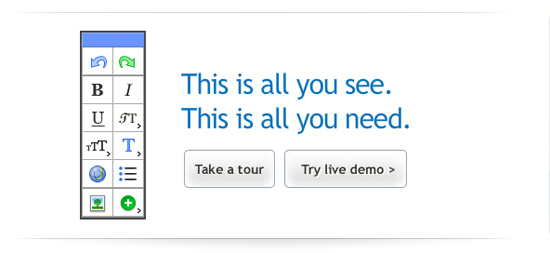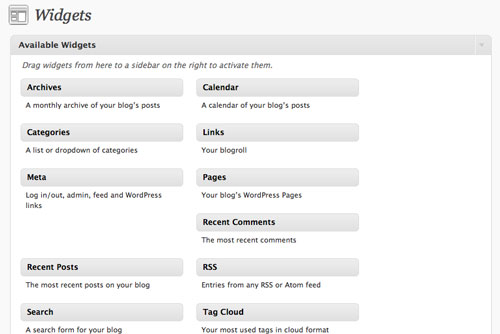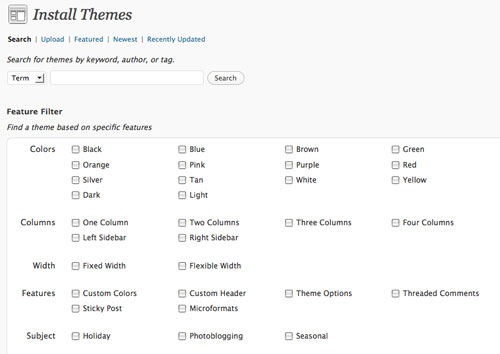WordPress is the most popular CMS currently, WordPress focused entries garner more attention then other topics. Even though we like WordPress a lot or not, it’s always good to know what other options there are out there.
I chose some of the most known one next to WordPress to the most obscure ones. Varying form flat files to full mySQL database. Ones that require almost no knowledge to get up and running, although most CMS now a days are becoming more and more easily to install(not Movable Type).
Should it happen you are in a spot where you are not able to use WordPress, check out these 10 CMS that differ greatly from each other.
Zimplit

Zimplit is the easiest CMS (Content Management System) ever made.
Zimplit is extremely lightweight, simple and customizable. It’s easy to install, and easy to use via a simple web interface. Zimplit consists of only one core engine file
* Price: Free
* Server Language: PHP v-4.x
* Database: No
* Self-Hosted: Yes
* Plug-ins: No. But themes are available.
SkyBlueCanvas

SkyBlueCanvas Lightweight CMS is an open source, free content management system written in php and built specifically for small web sites.
Lightweight and simple does not mean simplistic, however. SkyBlueCanvas includes a lot of the same basic abilities as more robust systems but in a simpler form. The software is not meant to be all things to all users but it does offer features you expect like a familiar Plugin API, Extensibility and skinnability.
* Price: Free
* Server Language: PHP v4-5.x – Only Linux Servers
* Database: No
* Self-Hosted: No
* Plug-ins: Yes
razorCMS

razorCMS, the flat file content management system, that can be as small or large as you wish. It’s structure allows you to have just the amount of functionality you need in a flat file CMS solution, helping to keep speed and simplicity at a maximum. razorCMS is ideally suited to small to medium website projects, it can be run without need for a SQL database, due to it’s flat file structure it has no need for a database meaning it can also be a cost effected method in content management, allowing it to be used on the cheapest of web hosts, or even free hosting.
* Price: Free
* Server Language: PHP v-5.x
* Database: No
* Self-Hosted: No
* Plug-ins: Yes
LotusCMS

LotusCMS brings to the forefront design and design integration into one of the most neglected CMS niches – Databaseless Web-Design and Development.
* Price: Free
* Server Language: PHP v-5.x
* Database: No
* Self-Hosted: No
* Plug-ins: No.
TypePad

TypePad blogs make it simple for you to share your interests and get noticed.
Easily design and customize your own blog, and use our SEO (Search Engine Optimization) and SMO (Social Media Optimization) tools to promote your blog and attract an audience and following.
* Price: Paid + Free Trial
* Database: Yes
* Self-Hosted: Yes
* Plug-ins: Widgets and Themes
Movable Type

It’s easier than ever to publish and share information with Movable Type. Movable Type makes it simple to manage entire websites, start new blogs, and build an engaged community of readers and customers.
* Price: Free + Paid
* Server Language: Perl
* Database: Yes
* Self-Hosted: No
* Plug-ins: Yes and Themes
Nucleus CMS

Nucleus CMS is a flexible and easy to install content management system, aka blog software. It helps you to publish a website and lets writers do what they are best at: writing items or articles, without having to worry about formatting and markup.
* Price: Free
* Server Language: PHP 4.0.6 or higher
* Database: Yes
* Self-Hosted: No
* Plug-ins: Yes and Themes
b2ecolution

b2evolution is a powerful blog tool. It includes all the features of traditional blog tools, and extends them with evolved features such as file & photo management, versatile skins, multiple blogs, detailed user permissions… not to mention plug-ins, of course.
* Price: Free
* Server Language: PHP version 4.3.2 or higher.
* Database: Yes
* Self-Hosted: No
* Plug-ins: Yes and Themes
Drupal

Use Drupal to build everything from personal blogs to enterprise applications. Thousands of add-on modules and designs let you build any site you can imagine.
* Price: Free
* Server Language: Recommended: PHP 5.2 for Drupal 5 and 6, PHP 5.3 for Drupal 7 Required: PHP version 4.4.0 or higher.
* Database: Yes
* Self-Hosted: No
* Plug-ins: Yes and Themes
Textpattern

Textpattern is an open source content management system unlike any other; it allows you to easily create, edit and publish content and make it beautiful in a professional, standards-compliant manner.
* Price: Free
* Server Language: PHP 4.4.1+ or 5.0.2+, in mod_php or fastcgi mode.
* Database: Yes
* Self-Hosted: No
* Plug-ins: Yes and Themes


